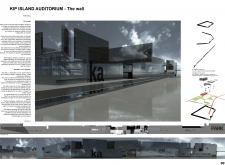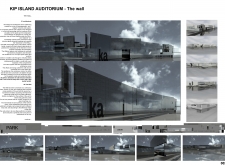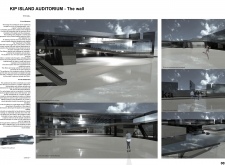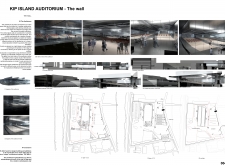5 key facts about this project
At its core, the project is designed to serve a dual purpose—housing commercial spaces on the ground level while providing residential units above. This mixed-use approach not only promotes urban density but also enhances the vibrancy of the area. The ground floor, featuring large, inviting storefronts, aims to foster interaction among residents and visitors, encouraging pedestrian activity and supporting local businesses.
The architectural design is characterized by a deliberate choice of materials, including local stone, timber, and expansive glass. The use of stone on the lower levels grounds the building in its context, providing a sense of permanence and stability. Timber elements add warmth and texture, contributing to a welcoming atmosphere, while the extensive use of glass allows natural light to flood the interiors and offers unobstructed views of the surroundings. This choice promotes a visual connection between the interior spaces and the exterior environment, enhancing the overall user experience.
The layout of the building prioritizes functionality and accessibility. Well-considered circulation patterns guide both residents and visitors through the space with ease. The residential units are organized to optimize views and natural light, with balconies and terraces designed to encourage outdoor living. This focus on creating livable environments supports a sense of community and enhances the quality of life for its occupants.
Unique design approaches also play a pivotal role in this project. The incorporation of green roofs and vertical gardens reflects a commitment to sustainability and environmentally responsible practices. These features not only contribute to the building’s aesthetic appeal but also provide ecological benefits, promoting biodiversity and improving air quality. Furthermore, the design includes energy-efficient systems that reduce the overall carbon footprint of the building, illustrating a proactive approach to climate-responsive architecture.
The architectural forms and proportions are meticulously considered to create a rhythmic aesthetic that resonates with the urban fabric. The façade features a combination of horizontal and vertical elements that create visual interest and a sense of movement. Careful attention to detail is evident in the selection of materials and finishes, which complement the overall design intent while ensuring durability.
Beyond the physical attributes, the project embodies a broader vision of community integration and sustainability. By incorporating public spaces, such as small parks and seating areas, the building invites social interaction, thus enhancing the neighborhood's sense of place. This aspect of the design reinforces the idea that architecture is not solely about creating structures but about fostering human connections and promoting well-being within urban environments.
As you explore the project presentation, you will find architectural plans and sections that provide further insight into the design process and decisions. Delve into the architectural designs that illustrate the thoughtful interplay of space, light, and materials, and consider the architectural ideas that exemplify modern, sustainable practices. Engaging with these elements will offer a deeper understanding of how this project stands as a significant contribution to contemporary architecture and urban life.


























